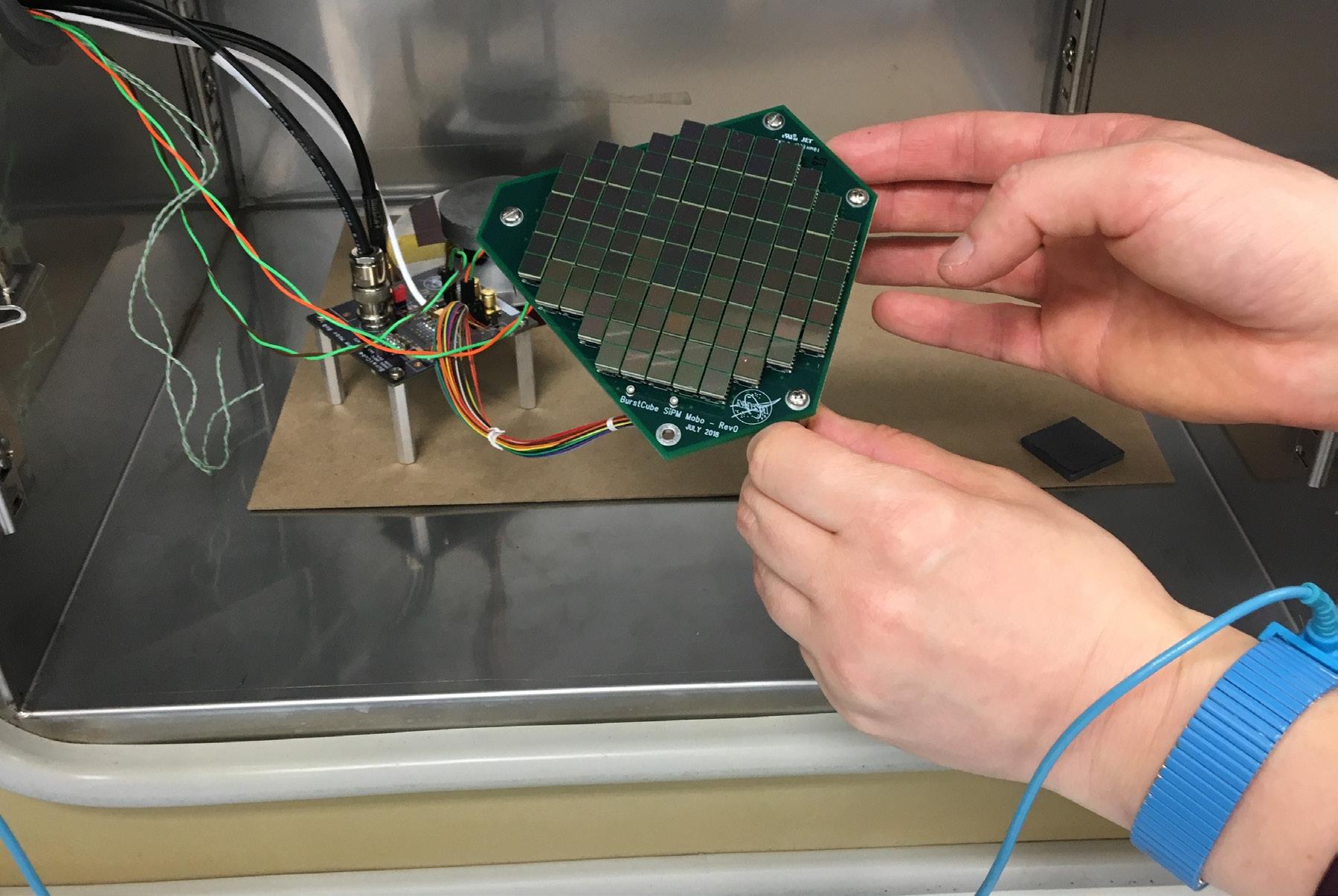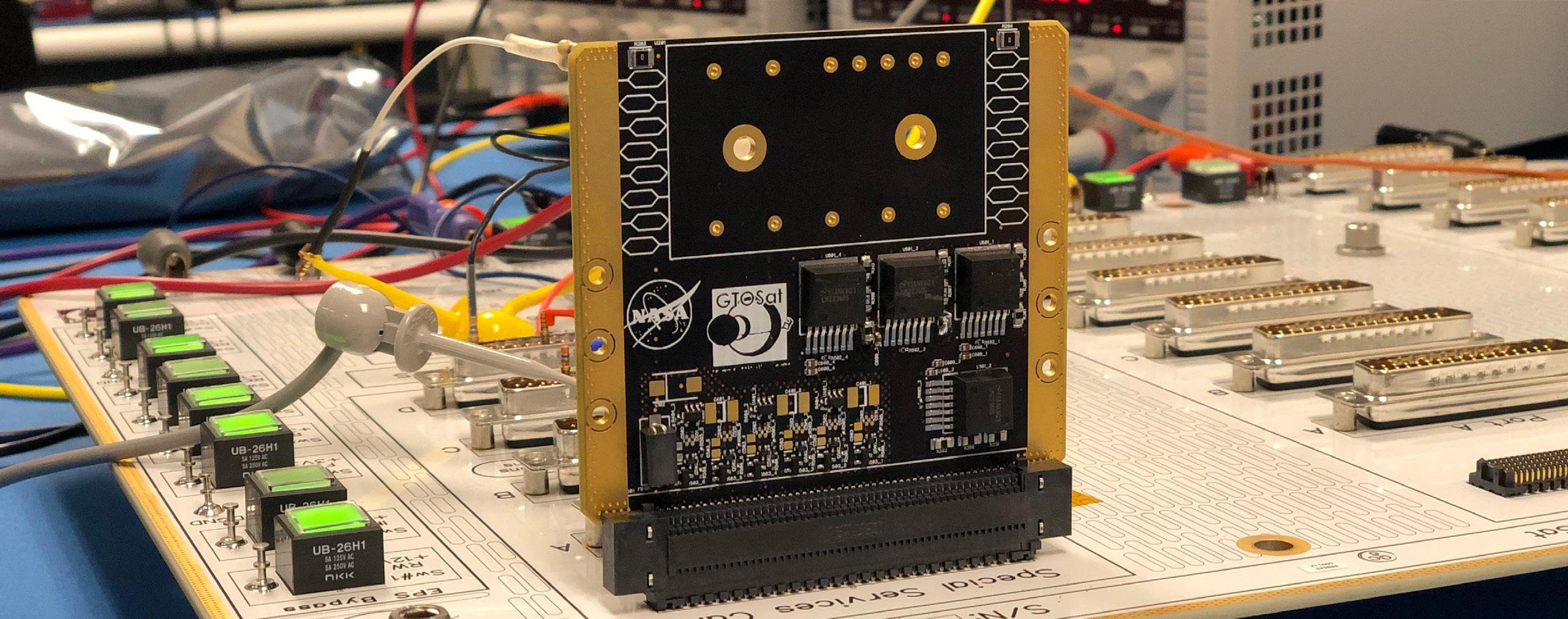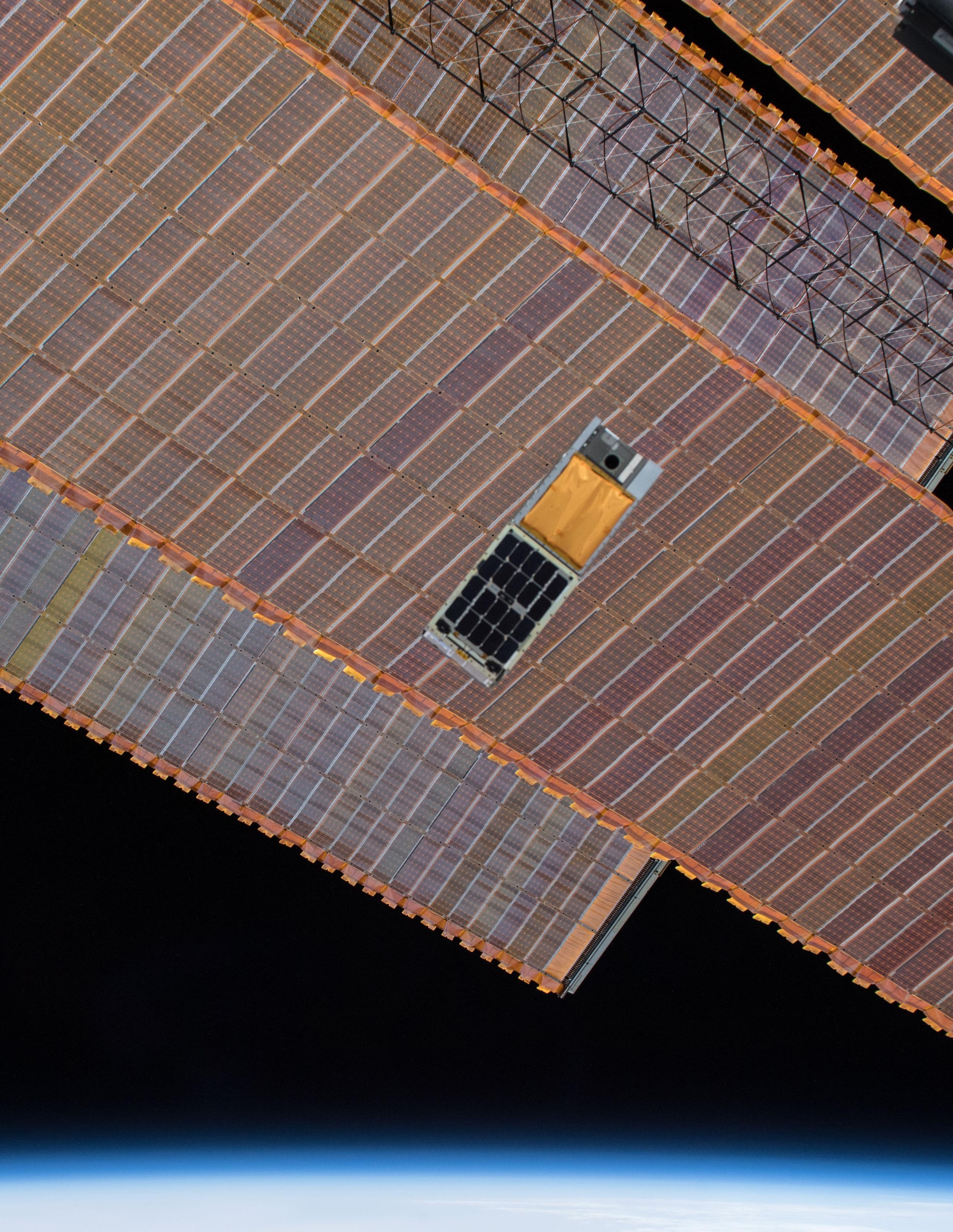
13 minute read
Goddard CubeSat Missions
Building on a strong foundation of CubeSat development from the past decade, Goddard has five upcoming CubeSat missions that will tackle groundbreaking science objectives and demonstrate new technologies in space. The CubeSat platform has come into its own, making it an appealing and affordable option for Goddard’s scientists and engineers. Spanning many Goddard scientific disciplines and areas of study, these five missions will continue to advance CubeSats as a versatile approach to spaceflight and validate new technologies for industry and university use.
BURSTCUBE The BurstCube mission shows that small satellites can go after big objectives. The CubeSat will carry instruments designed to detect gravitational wave event counterparts called short gamma ray bursts. These cosmic signals coincide with gravitational wave events, which are ripples in space-time created by exceptionally violent and explosive events, such as black hole collisions.
BurstCube’s instrument consists of four scintillator crystals paired with silicon photomultiplier arrays. Photons from traveling gamma rays are absorbed in the scintillator crystal because of its molecular structure. When a photon bumps into a molecule inside the crystal, an electron gets kicked into a higher energy state. When this electron drops back down into a low energy state, it creates a flash of light that the silicon photomultipliers can measure.
The BurstCube mission will feature a new capability for CubeSats – connecting to NASA’s Tracking and Data Relay Satellites (TDRS), which quickly relay data for a variety of NASA missions. Most CubeSat missions aren’t equipped with radios capable of connecting to NASA’s advanced communications networks, but with CubeSats like BurstCube, that paradigm is changing.
For Goddard, the silicon photomultiplier arrays will enable the BurstCube mission to supplement gravitational wave research on a relatively small, inexpensive platform. Not only will BurstCube be able to detect gamma ray bursts, but it will also provide information about where in the sky the gamma ray burst came from. With access to
BurstCube’s silicon photomultiplier arrays will help the CubeSat supplement gravitational wave research.
Photo Credit: NASA/Amy Klarup TDRS, BurstCube can relay that information quickly to the ground.
As mission preparation carries forward, Principal Investigator Jeremy Perkins says they’ve made some adjustments to BurstCube’s instrument based on results from a Naval Research Laboratory mission, which recently flew a similar silicon photomultiplier technology.
“It’s really beneficial to gain this experience on small platforms, where you can take on more risk,” Perkins says.
DIONE Goddard flies satellites that study weather patterns on Earth as well as in space, and a CubeSat named Dione will turn its focus on the latter when it launches into low Earth orbit. Dione will be packed to the brim with information-gathering technologies, carrying one engineering experiment and four science instruments.
The CubeSat shares several instruments in common with another Goddard mission – just like petitSat, Dione will fly INMS and GRIDS. In addition to those two science instruments, Dione will also carry a flight-tested fluxgate magnetometer and the brand-new Dual Electrostatic Analyzer, which has not yet flown in space. Eftyhia Zesta is the principal investigator for the Dione mission.
Space weather typically comes from the Sun in the form of solar flares or coronal mass ejections, which send dollops of radiation into Earth’s atmosphere and can cause trouble for satellites. With Dione’s full ensemble of instruments, the team will study the effects of solar energy on Earth’s magnetosphere and gather information to help predict space weather events.
In the future, NASA might fly an entire constellation of Dione-like spacecraft, working in tandem to take measurements from different locations in orbit. This is part of a larger movement at Goddard to pursue missions that feature small spacecraft flying in constellations. With CubeSats serving as testbeds for miniaturized technology, NASA can chase after heliophysics questions that still need answers.
GTOSAT This hardy CubeSat is bound for a volatile environment where few CubeSats have dared to travel before – into the radiation-heavy Van Allen Belts, where charged particles endanger the function of a CubeSat’s sensitive equipment. GTOSat (short for Geosynchronous Transfer Orbit Satellite) will need shielding and radiation-tolerant components to survive its mission into this harsh region around Earth.
“It’s been a challenge designing for this intense radiation environment, because a lot of CubeSat components and subsystems currently on the market are not radiation tolerant,” says Lauren Blum, a Goddard scientist and principal investigator for the GTOSat mission.
Blum and her team are up for the challenge. The Van Allen Belts are donut-shaped areas in Earth’s magnetosphere that contain highly energetic particles capable of causing significant damage to satellites. Blum says GTOSat will use two instruments to study these important regions.
The first instrument is an energy particle detector called the Relativistic Electron Magnetic Spectrometer (REMS). REMS is based on an instrument onboard the Van Allen Probes, a NASA mission launched in 2012 to study the Van Allen belts. Using a magnet to bend energetic electrons onto a plane of detectors, REMS will measure the energy spectrum of electrons in the outer belt.
— Lauren Blum, GTOSat Principal Investigator
Photo Credit: NASA/Scott Hesh

Goddard engineers test CubeSat components on a “flatsat,” which serves as a testbed before the CubeSat mission is finished.
The second instrument, a flux gate magnetometer, will measure Earth’s magnetic field, giving a reference point to let the GTOSat team know where electrons are coming from relative to the field.
GTOSat breaks the mold in another way – while most CubeSat missions fly in Low Earth Orbit (LEO) because of the greater availability of flight opportunities, GTOSat will take a radically different orbit from LEO, swinging close to Earth and then flying far into the midst of the belts in an elliptical pattern, known as a geo-transfer orbit.
“As a pathfinder, GTOSat will demonstrate how CubeSats can be used beyond LEO,” Blum says.
PETITSAT Though diminutive in size, petitSat will tackle the challenging goal of studying Earth’s ionosphere. Short for Plasma Enhancements in The Ionosphere-Thermosphere Satellite, petitSat carries two instruments – the Ion-Neutral Mass Spectrometer (INMS) and the Gridded Retarding Ion Drift Sensor (GRIDS).
The Goddard-developed INMS proved its space-worthiness on Dellingr, a CubeSat that launched in 2017. As part of the Dellingr mission, INMS successfully detected ions in the atmosphere. Engineers built another INMS for the petitSat mission, and this instrument will focus its efforts on studying irregularities in the density of Earth’s ionosphere. The gaseous ionosphere is filled with electrically charged atoms and molecules, including pockets filled with unusual densities of electrons. Goddard scientists are interested in studying these irregularities because they can interfere with GPS and radar signals that NASA satellites use to communicate and send data back to Earth. When a radio wave hits an irregularity as it travels through the ionosphere, it can become distorted, impacting the quality of the transmission.
With the GRIDS instrument, provided by Utah State University and Virginia Tech, petitSat will be able to measure ion characteristics such as temperature, density, and drift. Together, INMS and GRIDS will provide a more complete picture of the ionosphere’s plasma environment, helping scientists gain valuable information about the mechanisms at play.
“The petitSat mission builds off of Goddard’s work with the Dellingr mission and is paving the way forward for other missions to examine Earth’s upper atmosphere,” says Jeff Klenzing, the mission’s principal investigator. “The INMS and GRIDS instruments will also fly onboard the Dione mission.”
SNOOPI This Goddard CubeSat mission will test out a new technique to measure deep soil moisture, a metric that could prove useful for agriculture as well as flood and drought predictions. Instead of generating its own radio signal, the SNOOPI mission (Signals of Opportunity: P-band Investigation) will embrace a resourceful approach by leveraging a preexisting commercial radio signal. The “signal of opportunity” offers a powerful P-band frequency source, which can penetrate deeper into the ground than other frequencies in current use. When the signal reflection returns to space, SNOOPI’s tiny antennas will pick it up to produce maps that are related to moisture in the soil. Rajat Bindlish, a Goddard scientist with the mission, says that the P-band frequency directly measures the deeper parts of the soil column known as “the root zone.”
“Current missions, like Soil Moisture Active Passive (SMAP), can only measure the surface soil moisture,” Bindlish says. “Soil moisture in the deeper layers is estimated using land surface models.”
With SNOOPI, Bindlish says, the team can make direct observations of root-zone soil moisture, which is important for agriculture and food security. Plant roots draw the water from deeper layers of the soil, and this information helps determine plant health and agricultural yield. It can also help forecast floods and drought.
“Wet soil in the deeper layers will lead to larger floods because the rainfall will run off instead of getting absorbed in the soil,” Bindlish adds. Lead Instrument Engineer Manuel Vega says that the team has built engineering models for the major subsystems of the instrument, and testing is the next step.
Jeffrey Piepmeier, a Goddard engineer with the SNOOPI mission, says that CubeSats make it possible to do technology demonstrations such as this one by offering a relatively low-cost, accessible platform. As part of a cohort of Goddard CubeSat missions, SNOOPI benefits from the successes and advances of its teammates.
Of CubeSats, Piepmeier says, “The hardware may be smaller, but the science, instrument calibration, and performance are not.”
The SNOOPI mission is led by Principal Investigator James Garrison of Purdue University.
This CAD model of the SNOOPI CubeSat shows the antennas that will pick up a preexisting commercial radio signal.

Some of NASA’s biggest missions have used propulsion systems to explore the far reaches of the solar system. Propulsion systems help a spacecraft accelerate in the vacuum of space, and they can be used to maneuver in orbit or guide interplanetary trajectories. Being small in mass and minimalist in design, small satellites rarely have propulsion systems and rely on the power of gravity to keep them flying. This can lead to problems when a spacecraft drifts out of orbit.
There is another application for propulsion: attitude control systems, or ACS. Engineers at NASA’s Goddard Space Flight Center have invented an actuator system designed specifically for CubeSats called the “Ion Control System.” Built to be efficient and scalable, the patent-pending Ion Control System (ICS) opens up new possibilities for SmallSat missions.
“With CubeSats, a lot of times they don’t have any propulsion system at all,” says Steven West, a mechanical engineer at Goddard. “You have drag in low Earth orbit, and over time your CubeSat loses its orbit and burns up.”
Though the idea of actuator systems for SmallSats has existed for decades, Goddard engineers began working on the ICS around four years ago. Goddard’s SmallSat ambitions have grown, with plans for formation flying of SmallSat constellations, and technology development has kept pace to accommodate those plans.
“In order to keep control of your spacecraft, you need to have precision ACS actuators,” West says. “It’s really a key technology for these future small spacecraft missions.”
IMPORTANT FEATURES The CubeSat platform lends itself well to technology development and testing, and the ICS is no exception.
“One great thing about CubeSats is that they are relatively inexpensive to fly,” says Bob Moss, a Goddard electrical engineer and lead for the ICS’ Internal Research and Development proposal. “You can have a quick turnaround for another mission while making a few improvements.” When building a propulsion system for a SmallSat, Moss and his team considered which characteristics would lead to success in space. These include safety, scalability, and efficiency.
Larger missions often use propulsion systems that are pressurized and feature flammable or toxic materials. Since SmallSats typically share a launch vehicle with a larger, more expensive primary payload, it’s important that secondary payloads don’t result in damage to the larger mission. Pressurized SmallSat systems can result in explosions and damage a primary payload that flies on the same launch vehicle.
The ICS uses a nontoxic, inert metal as fuel and isn’t pressurized, making it safer and reducing risk. In addition to being safe, the ICS is scalable, meaning it can be adapted to the size of a mission. The system uses commercial-off-the-shelf parts, and because of this, the ICS is inexpensive and integrates easily into a satellite bus.
Another key feature of the ICS is its efficiency. Because the system uses solid metal, it can carry more fuel in a compact fashion compared to gas or liquid fuel. Furthermore, the system’s design decreases overhead power loss, which increases overall efficiency compared to other propulsion system designs.
“The testing we’ve done shows we’ve increased the system efficiency, meaning the power output divided by power input, from 7 percent to nearly 50 percent, which really sets it apart from what others have been doing and any prior testing that we’ve performed,” says Dakotah Rusley, a Goddard electrical engineer.
APPLICATIONS The ICS could be used to extend the life of SmallSat missions in orbit. Satellites slowly succumb to drag while in low Earth orbit, but with a propulsion system, engineers could correct the spacecraft’s orbit and add months to the mission’s lifespan.
“The whole point of CubeSats is to enable real science on a small budget,” Rusley says. “If we can enable more science and longer mission duration without increasing the budget, we’re helping meet that goal.”
— DAKOTAH RUSLEY, GODDARD ELECTRICAL ENGINEER
The ICS also has applications in formation flying for SmallSat constellations. In 2015, Goddard flew a constellation of four large spacecraft called the Magnetospheric Multiscale Mission. Since then, Goddard has developed several SmallSat constellation concepts, all of which are still in early stages. An upcoming Goddard CubeSat mission called Signals of Opportunity: P-band Investigation (SNOOPI) could serve as a precursor to a follow-on constellation mission.

Technologies like the ICS enable these new types of missions by providing thrust that can keep the small spacecraft flying together while maintaining distance between them. As missions work through technology demonstrations on single CubeSat platforms, they pave the way for future constellations. The ICS will fly on the petitSat mission, which is scheduled to launch in late 2021, as a secondary payload to the CubeSat’s primary instruments. After six months of collecting science data, petitSat will turn on the ICS and gather data about its performance in space. Once the primary mission is complete, Moss and his team will use the ICS to adjust the spacecraft’s attitude and measure the results.
LICENSING OPPORTUNITIES The petitSat mission will increase the ICS’ Technology Readiness Level even further, but interested companies are welcome to contact Goddard’s Strategic Partnerships Office (SPO) about licensing this patent-pending technology. To learn more about the ICS, please read the Technology Opportunity Sheet (https://technology. nasa.gov/patent/GSC-TOPS-237) and contact SPO at techtransfer@gsfc.nasa.gov. As the chief technologist for the Engineering and Technology Directorate at NASA’s Goddard Space Flight Center, Michael Johnson keeps a close eye on the evolving landscape of SmallSat mission development. Small satellites, he says, are poised to accomplish incredible mission objectives that didn’t seem possible just a few years ago.
“It’s quite exciting that SmallSats are being used for deep space missions and going beyond low Earth orbit,” Johnson says. “At Goddard, we’re working to add more reliable capabilities to our SmallSat missions consistent with missions bound for deep space.” CubeSats surfaced more than 20 years ago as inexpensive and experimental platforms, meant to test new technologies and science concepts. These types of spacecraft typically take on a greater level of risk than traditional, more elaborate missions, which require extensive testing and thoroughly validated hardware. However, as SmallSat missions have blossomed in the past decade, Goddard engineers have come to view SmallSats as spacecraft that can adopt more challenging and complex objectives. This has resulted in an effort to boost the confidence of SmallSat missions as they grow to fill more central roles in NASA’s plans.




